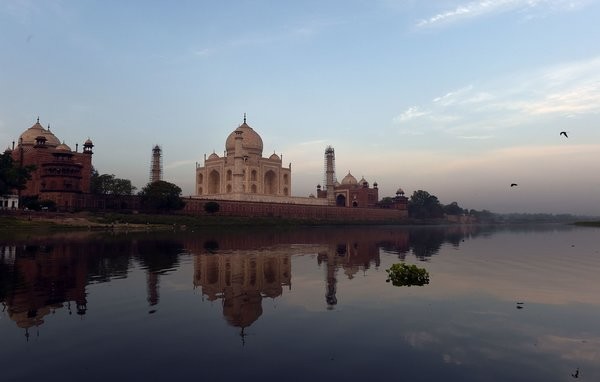Over the centuries, the Taj Mahal has endured its share of attacks — plundered by the Jats of northern India and looted by British soldiers, among other indignities. In recent years, officials have worried that growing air pollution could permanently darken the tomb’s brilliant white exterior.
But few people anticipated the latest affront — millions of mosquito-like insects, their numbers supercharged by nutritious algae blooming profusely along the banks of the polluted Yamuna River nearby. Like generations of romance-driven human couples before them, the bugs have swarmed the Taj Mahal on a mating flight, excreting a green substance on parts of its marble walls.
The Yamuna has suffered mightily in recent years from the dumping of solid waste in its waters, said an environmental activist in Agra, India, the site of the Taj Mahal.
“I have been constantly watching how the river pollution has gone from bad to worse,” said D.K. Joshi, who filed a petition over the insects in the National Green Tribunal, an environmental court last week. “The encroachments on and around the riverbed, the sewage going directly into the river” are choking it, he said.
On Monday, the National Green Tribunal issued notices to the central and local authorities, including the Ministry of Environment and Forests, telling them to respond to the petition this month.
With India’s cities ranking among the most polluted in the world by the World Health Organization, public concern over toxic air and water is mounting. The central government has pledged billions of rupees to cleaning the Ganges River. But the effect of pollution on India’s cultural heritage, though less obvious than its health effects, is also worthy of attention, experts say.
Sohail Hashmi, a Delhi-based writer and expert on heritage monuments, told Press Trust of India in an interview that the recently revived white limestone doors of the historic Red Fort, a former residence the Mughal emperor that was completed in 1648, “have become yellow in about six years.” Like the Red Fort, the Taj Mahal was built on the orders of Shah Jahan, a Mughal emperor, as a mausoleum for his beloved wife, and it was also finished in 1648.
The green secretions on the back wall of the Taj Mahal, a residue of the chlorophyll the insects consume, are not themselves harmful to the monument beyond the discoloration, said Girish Maheshwari, the head of the department of entomology at St. John’s College in Agra, who analyzed the problem for the Archaeological Survey of India.
But the explosive numbers of the insects — called Goeldichironomus — were an alarming indication of how polluted the river has become, he said, since their eggs thrive on phosphorus and sediment in the water. And he worried over the “highly synchronized” swarm of insects that descend on the monument in the evening.
They can create problems for the visitors,” he said.
The walls have been cleaned with clay packs, said Manoj Bhatnagar, an official in the Agra office of the archaeological survey. The excretions could also be removed with water, but the day-to-day cleaning is “very challenging.”
The insects do not seem to have deterred tourists, as yet. Samir Uberoi, who runs a tour company based in Mumbai, visited the Taj Mahal with groups twice in the last two weeks and did not notice a change. When asked what would happen if there was a significant recurring greening on the most loved monument in the country, he said, “I’m only hoping to God they find a solution before that.”
Puneet Dan, a tour guide in Agra, said he noticed the discoloration on the boundary wall of the Taj Mahal and on the back of the monument. So did his tourists, who he said flew into “semipanic mode.”
He said all he could do was assure them that officials were not about to let one of the greatest monuments in the world turn green.






Leave a reply